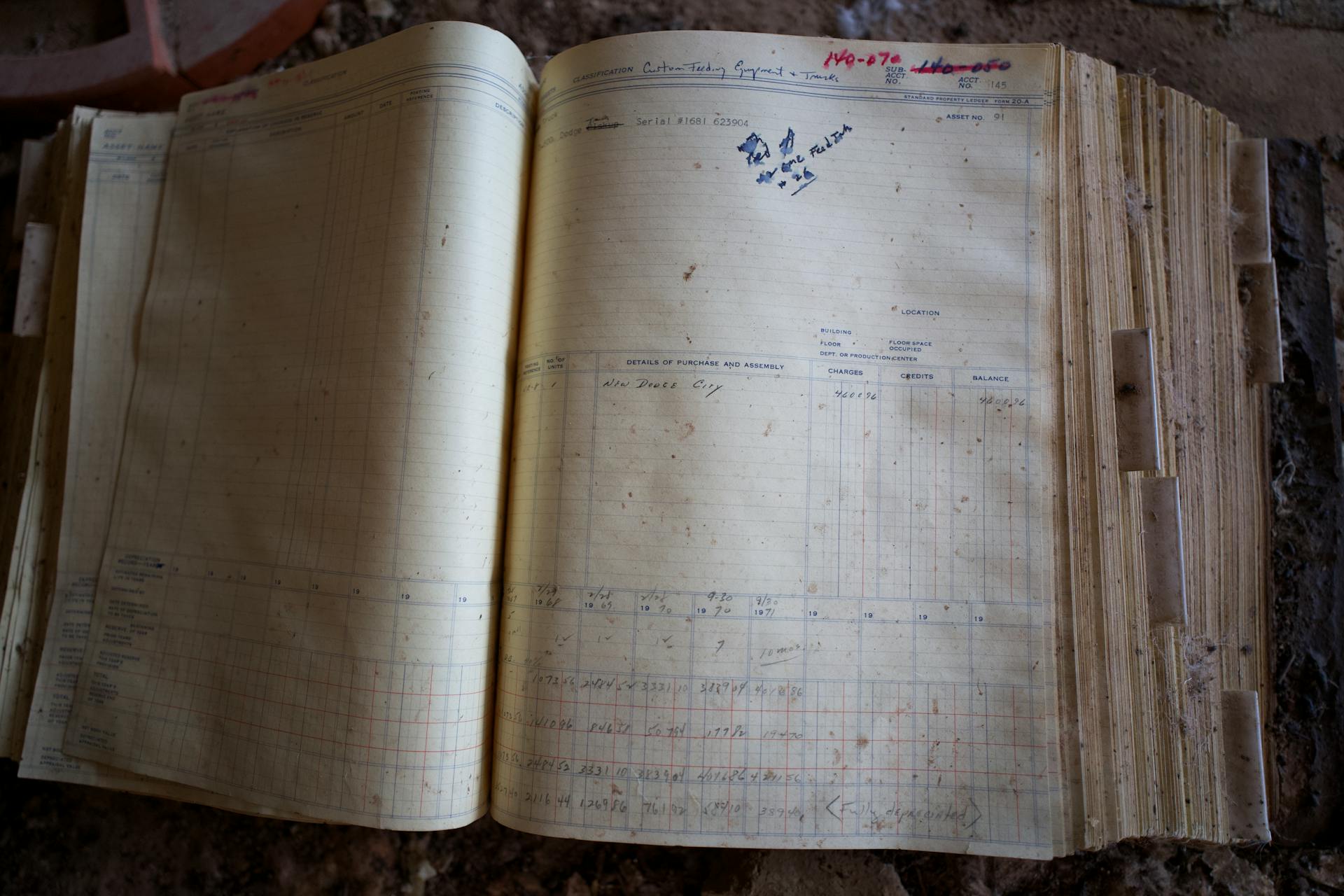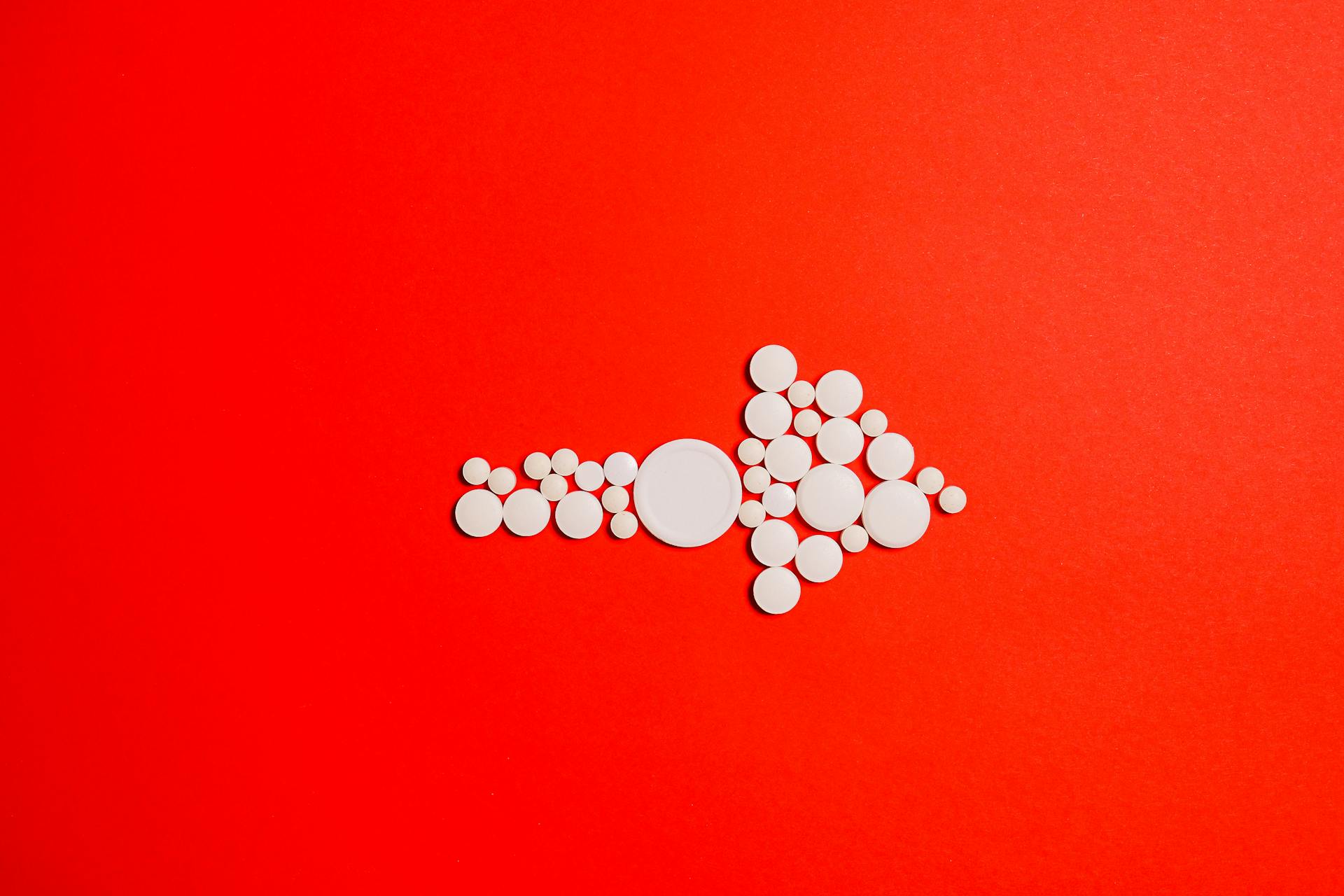
Recording accumulated depreciation is a crucial step in accounting for the value of assets over time. It's a process that helps you accurately reflect the costs of using up or wearing out assets, such as equipment or vehicles.
To start, you'll need to identify the asset's original cost and its current useful life. This will help you determine the annual depreciation expense and the total accumulated depreciation.
Accumulated depreciation is calculated by multiplying the annual depreciation expense by the number of years the asset has been in use. For example, if an asset's annual depreciation expense is $1,000 and it's been in use for 5 years, the accumulated depreciation would be $5,000.
As you record accumulated depreciation, be sure to keep track of the asset's remaining useful life and update the records accordingly. This will ensure that you're accurately reflecting the asset's value over time.
Intriguing read: Annual Depreciation Expense
Straight-Line Method
The straight-line method is a simple way to calculate accumulated depreciation. It's a straightforward formula that helps you determine the value of an asset over time.
To calculate accumulated depreciation using the straight-line method, you need to know the cost of the asset, its salvage value, and its life. Let's take the example of a truck with a cost of $25,000, a salvage value of $3,000, and a life of 15 years.
You start by subtracting the salvage value from the cost of the asset, which gives you $22,000. Next, you divide this value by the life of the asset, which is 15 years. This gives you $1,466.67.
Now, you multiply this value by the number of years you want to calculate the accumulated depreciation for. Let's say you want to calculate it for 3 years. This gives you $4,400.00.
Here's a simple breakdown of the steps:
- Subtract the salvage value from the cost of the asset.
- Divide the result by the life of the asset.
- Multiply the result by the number of years.
The original cost of an asset minus its accumulated depreciation is the current book value of the asset. For example, after three years, the book value of the truck would be $20,600, calculated as $25,000 - $4,400.00.
The formula for the straight-line method can also be represented as: DE = (cost of the asset - salvage value) / life of the asset × number of years. Let's use the example of a toy-producing machine with a cost of $25,000, a salvage value of $3,000, and a life of 15 years, but with a different number of years: DE = (25,000 - 3,000) / 7,500 × 10,000.
Additional reading: In Computing Depreciation Salvage Value Is
The Declining Balance
The declining balance method is a great way to calculate depreciation, and it's actually quite simple once you understand the basics. In this method, the depreciation rate is applied to the current book value of the asset, rather than its original cost.
The formula for the declining balance method is AD = (current book value × depreciation rate) + sum of the previous years' depreciation. This means that each year, the depreciation expense is calculated by multiplying the current book value by the depreciation rate.
Let's use an example to illustrate this. Suppose we have an asset with a current book value of $25,000 and a depreciation rate of 10%. In the first year, the depreciation expense would be $2,500, calculated as $25,000 × 10%.
After the first year, the book value would decrease to $22,500, and the depreciation expense for the second year would be $2,250, calculated as $22,500 × 10%. The accumulated depreciation after two years would be the sum of the depreciation expenses from years 1 and 2, which is $4,750.
Here's a summary of the declining balance method:
As you can see, the declining balance method is a straightforward way to calculate depreciation, and it takes into account the decreasing book value of the asset over time.
Calculating Depreciation
To calculate depreciation, you need to know four things: the cost of the asset, the depreciation method, the useful life, and the residual value. The cost includes the purchase price, plus any shipping, taxes, installation, or customization costs.
The depreciation method can be straight-line or accelerated. Straight-line depreciation is the easiest to calculate, but accelerated depreciation front-loads depreciation expense to provide a bigger tax deduction early on.
The useful life of an asset varies by class, with common classes including 5 years for computers and 7 years for office furniture. The residual value, or salvage value, is what you can sell your asset for at the end of its useful life.
To calculate the annual depreciation expense, divide the cost by the useful life. For example, if an organization purchases a laptop for $1,000 and estimates it will last five years with zero residual value, the annual depreciation expense will be $200.
For more insights, see: Straight Line Depreciation Chart
Here are some common depreciation methods:
- Straight line
- Declining balance
- Sum of the year's digits
- Units of production
The sum-of-the-years-digits method is an accelerated depreciation method, where a higher expense is incurred in the early years and a lower expense in the latter years of the asset's useful life. To calculate the depreciation expense using this method, divide the remaining life by the sum of the years' digits and multiply by the depreciating base.
The sum of the years' digits can be calculated by adding together the digits representing the number of years of the asset's life. For example, if the asset has a 15-year life, the sum of the years' digits would be 1 + 2 + 3 + 4 + 5 + 6 + 7 + 8 + 9 + 10 + 11 + 12 + 13 + 14 + 15 = 120.
The formula for calculating the accumulated depreciation using the sum of the year's digits method is:
A different take: What Is Prior Year Accumulated Depreciation
(remaining life span/SYS × (cost of the asset - salvage value)) + sum of the previous years' depreciation,
where SYS is the sum of the year's digits.
Here's an example of how to calculate the accumulated depreciation using this formula:
The accumulated depreciation is the sum of the total depreciation expense from each year.
Recording Depreciation
Recording depreciation is a crucial step in accounting for fixed assets. It's recorded as a debit to a depreciation expense account and a credit to a contra asset account called accumulated depreciation.
The bookkeeping entry for depreciation is made every month until the balance in the accumulated depreciation account equals the purchase price or the asset is disposed of. For example, if a laptop has a purchase price of $1,000 and four full years of depreciation, the accumulated depreciation account will show a credit balance of $800, leaving a net book value of $200.
Here's a breakdown of the journal entry to record the disposal of the laptop:
Note that the disposal of the laptop results in a loss on disposal of $200, which is recorded as a debit to the Loss on Disposal account.
How to Record
To record depreciation, you'll need to make a journal entry every month until the asset is disposed of. This entry will debit the depreciation expense account and credit the accumulated depreciation account.
The journal entry will look something like this:
- Date: 4/30/21
- Account Name: Depreciation Expense
- DR: $16.70
- CR: Accumulated Depreciation
You'll make this entry every month until the accumulated depreciation account equals the purchase price of the asset. As a contra account, accumulated depreciation reduces the book value of the asset on the balance sheet.
The net book value of an asset is determined by taking the sum of the fixed asset account and the accumulated depreciation account. Over time, the net book value will decrease until the salvage value is reached.
Here's an example of how to record the disposal of a laptop:
- Date: 5/1/25
- Account Name: Accumulated Depreciation
- CR: $800
- Account Name: Loss on Disposal
- DR: $200
- Account Name: Fixed Asset – Computers
- CR: $1,000
Note that depreciation is a non-cash entry, meaning no cash is going out of your bank account for this expense item. This becomes a factor in your statement of cash flows.
If you have multiple fixed assets, you'll need to make separate journal entries for each one. However, some accounting software may limit the number of accounts that can be created, so you may need to summarize entries per fixed asset class.
Take a look at this: Is Depreciation a Non Cash Expense
What Type of Account
Accumulated depreciation is a contra asset account. Its balance is a credit that reduces the asset's value.
You can find the asset's carrying value on the balance sheet, showing the difference between historical cost and accumulated depreciation. This value is listed as the asset's carrying value.
The accumulated depreciation account is called a long-term contra asset account.
Related reading: The Normal Balance of the Accumulated Depreciation Account Is Debit
Sources
- https://corporatefinanceinstitute.com/resources/accounting/types-depreciation-methods/
- https://www.omnicalculator.com/finance/accumulated-depreciation
- https://floqast.com/blog/fixed-asset-depreciation-journal-entry/
- https://fitsmallbusiness.com/how-to-record-depreciation-journal-entry/
- https://gocardless.com/en-us/guides/posts/what-is-accumulated-depreciation-formula/
Featured Images: pexels.com


